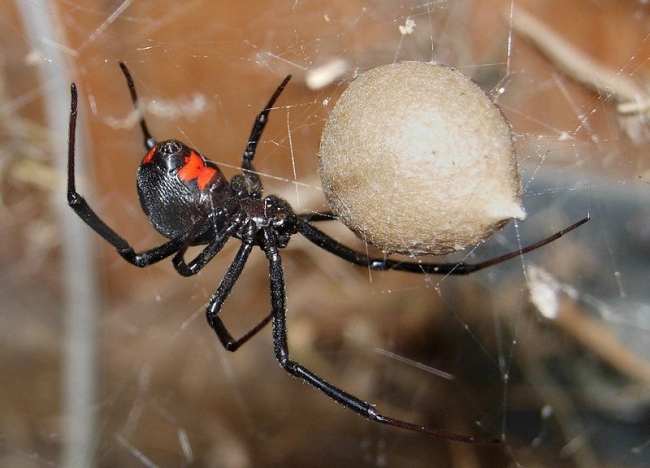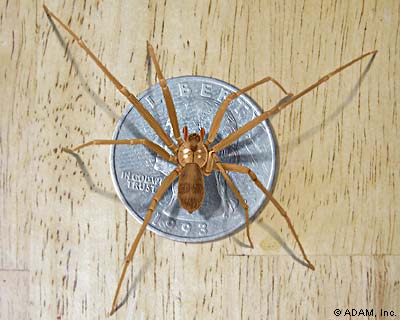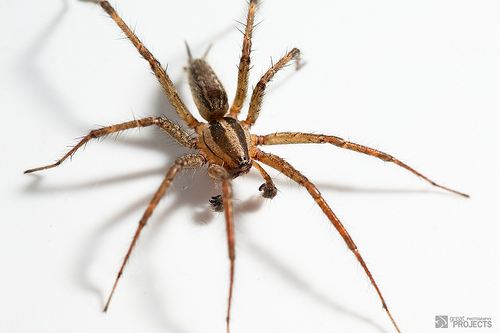Spiders
Most spiders pose no threat to humans. In fact, of the 20,000 species of spiders that inhabit the Americas, only 60 are capable of biting humans. Within that small group, only a handful of species are known to be dangerous to humans. Of these, only the brown recluse and the black widow have ever been associated with significant harm and rare reports of death. Tarantula bites, despite common fears, are not significantly more dangerous to humans than wasp stings.
- Black widow spiders are perhaps the most venomous spiders in North America.
-
- Identification. The female black widow is normally shiny black, with a red hourglass marking on the underside of the abdomen. The abdominal marking may range in color from yellowish orange to red and its shape may range from an hourglass to a dot. In a few widow spiders, however, no pattern is obvious on the abdomen. The body of an adult black widow female is about 1/2 inch long while the male widow spiders are smaller. They usually are not black in overall color, instead appear light brown or gray and banded. Male widows may have an hourglass pattern, but coloration often is more orange and sometimes yellow. Widow spiders build loose and irregular mesh-type webs, often on plants, in loose stone or wood piles, or in the corners of rooms, garages or outbuildings. They do not produce the symmetrical web typical of orb weaving spiders or the distinctive funnel pattern web of the funnel weaver
 spiders.
spiders. - Symptoms of bite. While the area around the bite may experience swelling, the venom is primarily a neurotoxin, which does not cause significant local tissue death and destruction. Rather, the venom, as well as other neurotoxins, affects the nervous system of the afflicted animal. Without medical attention, the symptoms of a black widow bite can last for days and a complete recovery may take weeks. Black widow bites commonly cause the following ailments:
- painful rigidity in the muscles of the abdomen
- tightness in the chest and labored breathing
- increase in blood pressure
- a rise in body temperature
- nausea
- sweating
- death is uncommon (less than 1% of the reported cases), but in the elderly or very young death may occur from asphyxia. Seek medical attention if you suspect you have been bitten.
- Habitat. Black widow spiders and their relatives can be found almost anywhere in the Western hemisphere of the world in damp and dark places. The spider prefers the following environments: woodpiles, rubble piles, under stones, in hollow stumps, and in rodent burrows, sheds and garages. Indoors, they are found in undisturbed, cluttered areas in basements and crawl spaces.
- Identification. The female black widow is normally shiny black, with a red hourglass marking on the underside of the abdomen. The abdominal marking may range in color from yellowish orange to red and its shape may range from an hourglass to a dot. In a few widow spiders, however, no pattern is obvious on the abdomen. The body of an adult black widow female is about 1/2 inch long while the male widow spiders are smaller. They usually are not black in overall color, instead appear light brown or gray and banded. Male widows may have an hourglass pattern, but coloration often is more orange and sometimes yellow. Widow spiders build loose and irregular mesh-type webs, often on plants, in loose stone or wood piles, or in the corners of rooms, garages or outbuildings. They do not produce the symmetrical web typical of orb weaving spiders or the distinctive funnel pattern web of the funnel weaver
- Brown Recluse. Along with the black widow, the brown recluse is potentially the most dangerous spider in North America. Despite their reclusive habits, they do occasionally bite humans. Recluses typically bite when they are trapped between flesh and another surface, as when a sleeping human rolls over on a prowling spider, or when putting on clothing or shoes containing the spider.

- Identification. The brown recluse is usually between 1/4 inch to 3/4 inch (6mm 20mm), but may grow larger. They are notable for their characteristic violin pattern on the back of their cephalothorax-the body part to which the legs attach. These spiders are not aggressive and bite only when threatened, usually when pressed up against the victim's skin. They seek out dark, warm, dry environments such as attics, closets, porches, barns, basements, woodpiles and old tires.
- Symptoms of bite:
- Severe pain at bite site after about four hours;
- Severe itching;
- Nausea;
- Vomiting;
- Fever;
- muscle pain; and
- Potentially severe local tissue damage.
- Identification. The brown recluse is usually between 1/4 inch to 3/4 inch (6mm 20mm), but may grow larger. They are notable for their characteristic violin pattern on the back of their cephalothorax-the body part to which the legs attach. These spiders are not aggressive and bite only when threatened, usually when pressed up against the victim's skin. They seek out dark, warm, dry environments such as attics, closets, porches, barns, basements, woodpiles and old tires.
-
Hobo Spider. This spider is not native to the U.S., but by the mid 1960's, it had become established in Washington, Oregon, Idaho, and British Columbia. Current distribution places it also in Montana, northern Utah, and western Wyoming. Although the bite of the hobo spider is initially painless, the bite can be serious. Hobo spiders are often confused with Wolf Spiders, which produce a painful but relatively harmless bite. If serious symptoms develop, the victim should seek medical attention.
- Symptoms of bite:

- immediate redness, which develops around the bite;
- After 24 hours, the bite develops into a blister and after 24-36 hours, the blister breaks open, leaving an open, oozing ulceration;
- severe headache;
- temporary memory loss;
- impairment of vision;
- nausea; and
- weakness.
Spider Prevention
Entry of spiders into homes can be discouraged by increasing lighting of darkened corners, such as by appropriate furniture arrangement or use of artificial lighting. Insecticides should be applied in dark, undisturbed areas where spiders are likely to produce webs. Insecticides also can be used to prevent spider migrations into homes by spraying around the exterior foundation and lower story windows. Preventative spraying should be performed before temperatures get cold, as at this point spiders, and other insects, may have already entered the house. The insecticide chlorpyrifos (Dursban) is the most widely available product for control of spiders around a home. Chlorpyrifos has a residual effectiveness of several weeks, particularly if not exposed to light and moisture. However, it is moderately toxic to humans.
For more information: HOMEINSPECTORUSA

Comments(1)